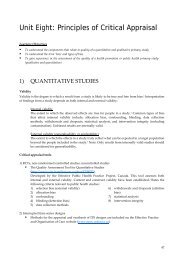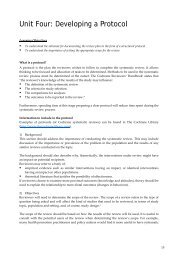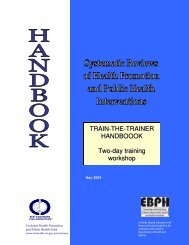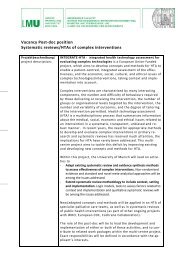Guide for Developing a Cochrane Protocol - Cochrane Public Health ...
Guide for Developing a Cochrane Protocol - Cochrane Public Health ...
Guide for Developing a Cochrane Protocol - Cochrane Public Health ...
Create successful ePaper yourself
Turn your PDF publications into a flip-book with our unique Google optimized e-Paper software.
design due to ethical or other reasons the review needs to be explicit about which study designs<br />
are appropriate to include and why. It may be appropriate to include more than one study design,<br />
even if it is likely that RCTs are available, to increase external validity of the review findings.<br />
Studies should be included irrespective of their publication status, unless explicitly justified in<br />
your protocol.<br />
The CPHG accepts the following study designs as appropriate to the review question: RCTs,<br />
cluster RCTs, non-randomised controlled studies (including controlled be<strong>for</strong>e and after studies<br />
and interrupted time series studies (with three time points be<strong>for</strong>e and after the intervention).<br />
Whilst there are challenges associated with using study labels, authors are encouraged to refer to<br />
Box 13.1.a of the <strong>Cochrane</strong> Handbook to ensure they are clear about the types of study design<br />
descriptors they might find in the literature. You could consider including a list of definitions of<br />
your chosen study designs. The focus <strong>for</strong> eligibility must be on the features of a study’s design,<br />
rather than the design labels used. You should state in this section if you will be collecting and<br />
extracting in<strong>for</strong>mation from qualitative studies emanating from included intervention studies.<br />
Qualitative research studies can be used in the review to help contextualize the major findings,<br />
rather than provide causative understandings. The extent to which you search <strong>for</strong> and include<br />
qualitative studies will depend on the questions you wish to answer in your review.<br />
Types of participants<br />
Clearly describe the population <strong>for</strong> which the intervention under review is targeted at or likely to<br />
have an effect on, and clearly specify inclusion and exclusion criteria <strong>for</strong> your review. These may<br />
be based on individuals or communities. Examples of defining characteristics may be geographic<br />
(e.g. where they live or work), demographic (e.g. age, sex) and/or social factors (e.g. education<br />
level, ‘at-risk’ groups (as specified by the authors). Any restrictions with respect to specific<br />
population characteristics, settings or factors needs to be justified and reflect in<strong>for</strong>mation<br />
presented in the Background section. Many reviews published within the remit of the CPHG will<br />
have community as their participants. Reviews should provide a definition <strong>for</strong> community that is<br />
appropriate <strong>for</strong> the intervention. It is important to distinguish between ‘community-wide’ and<br />
‘community-based’ interventions, if these terms are used in your review.<br />
Types of interventions<br />
List the intervention/s that will be included in the review, and specify clear inclusion and<br />
exclusion criteria (e.g. any essential components, minimum duration of the intervention, etc.).<br />
This section should not describe or define interventions - this detail should be included in the<br />
Background section (Description of the intervention). This section should there<strong>for</strong>e be brief and<br />
outline the types or groups of included interventions, as referred to in the Background section.<br />
Authors should also include a list of the interventions that will be excluded from the review.<br />
Include specific examples of relevant interventions/programs of both included and excluded<br />
studies when possible. If relevant to the inclusion criteria, identify any specific intervention/s<br />
your intervention/s of interest should be compared against (i.e. what the control group will be).<br />
Types of outcome measures<br />
The outcomes you plan to report <strong>for</strong> your review should be pre-specified in your review to avoid<br />
bias in reporting your findings. If possible, you should also define in advance the details of what<br />
will be considered acceptable outcome measures <strong>for</strong> your review and also how outcome<br />
Last updated: 24 November 2011 - 7 -








